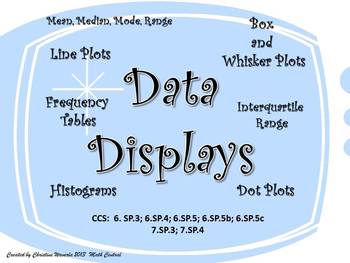Data Displays: Line Plots, Histograms, Box and Whisker Plots, Frequency Tables
- PDF
What educators are saying
Description
This is one of my favorite teaching tools!
I created this Data Display set of worksheets this year for my 6th grade class. My students loved using these worksheets to practice their new skills. Each worksheet provides plenty of room for students to create their data displays and answer questions based on the data. Questions ask students to find the mean, median, mode, range, interquartile range, and percentages.
These worksheets are fully aligned with the Common Core Curriculum.
CCS: 6.SP.3; 6.SP.4; 6.SP.5; 6.SP.5b; 6.SP.5c 7.SP.3; 7.SP.4
Uses:
•Photocopy each worksheet and use them for practice, homework, and as a quick assessment of your students skills.
•Use them in a center or for a station activity.
•Display the worksheets on your white board or Smart Board and complete the data displays as a class.
•Include one of the worksheets in your next test.
•Use a worksheet or two as a quiz.
•Display the answer keys on the board for self checks.
A color and black and white copy are included.
Answer Key Included.
Check out my other products too!
Follow my store for updates and freebies!





